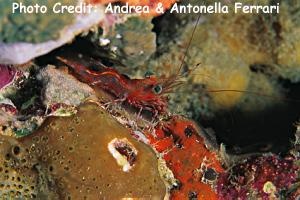
By Bob Goemans


Not Reef Tank Suitable
Likely Fish-Only Tank Suitable
Technically, these are called 'joint-legged animals,' and they are in the Phylum Arthropoda and found in marine environments with some not visible to the human eye. Nevertheless, for marine hobbyists those of interest, e.g., shrimp-like creatures are discussed here, with others in this Phylum, such as barnacles, crabs, lobsters, and sea spiders discussed elsewhere in the Species Library in separate sections.
As to shrimp-like creatures, they fall into the Subphylum Crustacea, which has over 32,000 described species and many yet undescribed species. Only a few of these are of interest to hobbyists. The two classes of major interest are Branchiopoda and Malacostraca, which contain by far the majority of animals we think of as crustaceans. Those in the Class Branchiopoda are mostly freshwater or brackish species, such as brine shrimp, usually incorrectly called Artemia salina, as this species is thought to be extinct. Yet one of the known species from the San Francisco area, Artemia franciscana, is regularly cultured for the aquarium trade. Another, the very common Daphnia pulex, would be familiar to freshwater aquarists, however, its also used as a marine fish food.
Nevertheless, those in the Class Malacostraca are of far more interest as it contains crabs, lobsters, prawns, shrimp, and crayfish. It's further divided into three subclasses, Phyllocarida, Hoplocarida and Eumalacostraca. As for Phyllocarida, its mostly ancient/primitive creatures, with most extinct. In the Subclass Hoplocarida, its Order Stomatopoda contains those dreaded mantis shrimps that are often undesirable in our aquariums.
In the Subclass Eumalacostraca, there are several superorders, two of which are of interest to marine aquarists. Its Superorder Peracarida contains small bottom-dwelling isopods and amphipods, along with small opossum shrimps we know as mysid shrimps.
The Superorder Eucarida contains two orders of significance. Order Euphausiacea contains the Pacific krill (Euphausia pacifica), which is an excellent foodstuff, either frozen or freeze-dried for our fishes. And probably the most interesting is the Order Decapoda (meaning 10 feet), which includes shrimps, prawns, lobsters, hermit crabs, and true crabs, and is composed of about 68 families containing almost 10,000 species.
This order is further divided into two suborders, Dendrobranchiata and Pleocyemata where those within it are classified by the structure of the gills and legs, and the way larvae develop. Those in the Suborder Dendrobranchiata release their eggs into the water and hatch as nauplii. And if shrimp are a people food in your household, a whole industry has been built around the culture of 'prawns' in this suborder. As for those in the Suborder Pleocyemata, its members cement their eggs to their pleopods (abdominal appendages) until they hatch, and these are of more interest to aquarists.
And once we move into the Suborder Pleocyemata, there are numerous 'infraorders' dedicated to various types of creatures, e.g., shrimp, lobsters, crabs, etc., and two have special interest if 'ornamental' type shrimp are of interest. In the Infraorder Stenopodidea, Family Stenopodidea, there's a very familiar species called the Banded Coral/Boxer shrimp Stenos hispidus. However, it's not really considered a shrimp! It's considered more a lobster-like creature. And the Infraorder Caridea is where the more familiar 'true shrimp' genera begin to show up.
Lets stay here with shrimp-like creatures, and if interested in other type joint-legged animals, such as barnacles, crabs, lobsters, and sea spiders, checkout their sections elsewhere in this library.
Furthermore, there are many in this Grouping that show up in the aquarium trade, with none being photosynthetic, and most requiring gentle to moderate water movement.
Therefore, as noted in other areas of this Species Library, some species may contain suggested PAR levels (N/A in this Grouping) and with Water Motion (WM) recommended levels.
As for water motion, I've decided to relate it to the visible intensity of water motion on that of a long tentacle anemone. No visible tentacle motion is '0,' whereas a slight movement of some tentacles is '1.' If all the tentacles are gently swaying in the current it is '2.' If all tentacles are moving fairly fast and bouncing into each other it is '3.' Should all tentacles be driven with such force they are extended in one direction or unable to sway back to their central position it's '4.'
In this grouping you will see them as - PAR - N/A & WM - X. Hopefully you'll find this quite helpful.
© 2012 Bob Goemans. All rights reserved.
The material on this site may not be reproduced, distributed, transmitted, cached or otherwise used, except with the prior written permission of Bob Goemans.

